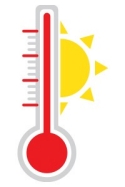Extreme Heat

Heat related deaths and illnesses are preventable. Still, more than 600 people in the United States are killed by extreme heat every year according to the Centers for Disease Control and Prevention (CDC). Heat is the number one weather related killer in the U.S.1 On average, more people are killed by heat in the U.S. than by other natural disasters (i.e., tornadoes, earthquakes, hurricanes, floods) combined.1
Extreme heat is defined as temperatures that are much hotter and/or humid than average for a particular location and the time of year. Extreme heat events are becoming more frequent, due to the warming of our planet. Prolonged hot weather can cause dehydration and increase the body’s core temperature, making it difficult for the body to function normally.
What Causes Heat Related Illness?
Heat illness occurs when the body cannot cool down. The body normally cools itself by sweating, however, sometimes that is not enough. In extreme heat, especially when humidity is high, sweat does not evaporate as quickly and the body has to work extra hard to maintain its normal temperature. Other factors can also contribute to how our body regulates temperature, such as age, health conditions, and medication or drug use.
There are several types of heat related illness: heat rash, heat cramps, heat exhaustion, and heat stroke. See Table 1 for types of heat related illnesses and their symptoms. The most serious form of heat related illness is heat stroke. This occurs when the body’s temperature rises quickly, the sweating mechanism fails, and the body cannot cool down. If not addressed on time, heat stroke can cause permanent damage or can lead to death.
Who is At Risk?
- Elderly (65+)
- Babies and young children
- People with pre-existing or chronic conditions, such as diabetes, high blood pressure, heart disease, mental illness, developmental disability, dementia, respiratory conditions, asthma, and obesity
- The unsheltered/homeless
- Outdoor workers and athletes
- People without air conditioning
- People living alone and socially isolated
- People taking diuretics, such as caffeine and alcohol or illegal drugs
- Your pets
How to Take Care of Myself?
- Stay somewhere cool or get to one of the County’s Cool Zones
- Take a cold shower or bath
- Stay hydrated and drink plenty of water
- Avoid drinks that contain alcohol, caffeine, and lots of sugar
- Wear light clothing and hats
- Avoid being outdoors during hottest part of the day (10am-4pm)
- Avoid strenuous activity
- Do not leave children in cars on hot days
- Do not leave pets in cars
How to Help Others?
- Check in on neighbors, family, or friends who are at increased risk, especially if they live alone
- Ensure they have access to plenty of water, ice in their freezer, and a fan if possible
- Offer to help them get to a cool zone or another cool location
What is the County’s Response?
In an extreme heat event, the Public Health Services branch of the County of San Diego Health and Human Services Agency is responsible for coordinating response efforts with other County departments and external partners.
For more information, see the consumer version of the Excessive Heat Response Plan.
TABLE 1. HEAT RELATED ILLNESSES
| HEAT RASH | |
| WHAT TO LOOK FOR | WHAT TO DO |
|
|
| HEAT CRAMPS | |
| WHAT TO LOOK FOR | WHAT TO DO |
|
|
| HEAT EXHAUSTION | |
| WHAT TO LOOK FOR | WHAT TO DO |
|
|
| HEAT STROKE | |
| WHAT TO LOOK FOR | WHAT TO DO |
|
|
| Source: Centers for Disease Control and Prevention | |
2021 Annual Excessive Heat Report
The 2021 Annual Excessive Heat Report details the number of Heat Alerts and heat events year-to-year, prehospital data and outcomes, Aging and Independence Services (AIS) activities, 2-1-1 San Diego activities, and the outreach efforts that the County Communications Office (CCO) completed.
View the Excessive Heat Report.







